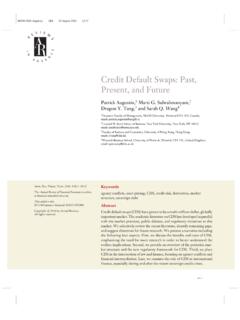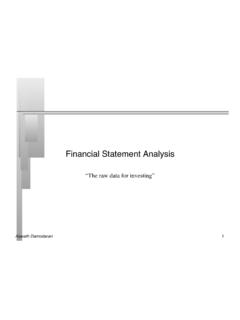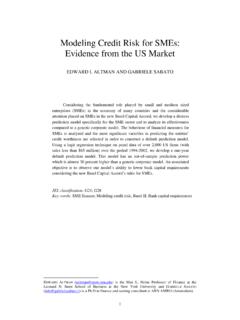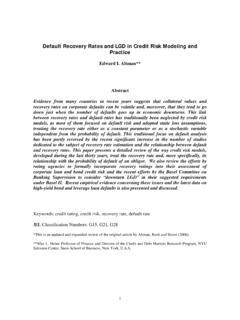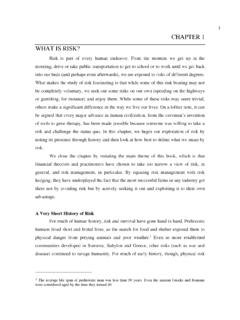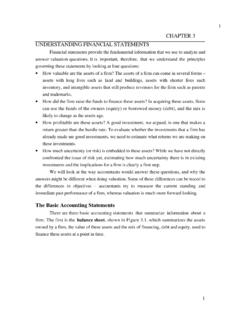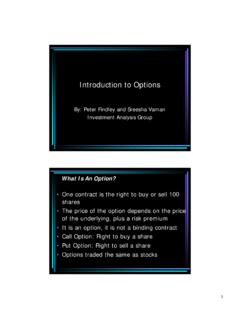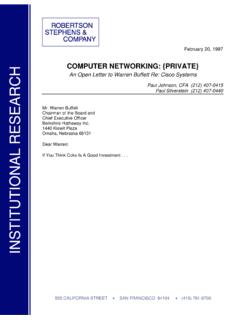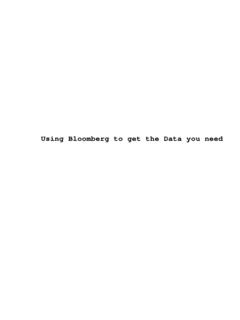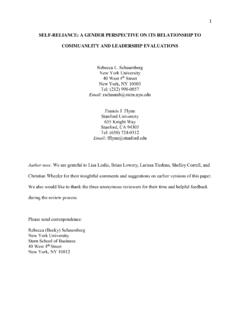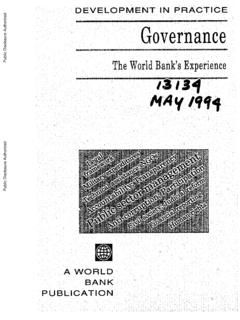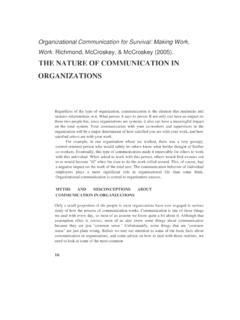Transcription of Information Technology and Corporate Strategy: A …
1 Information Technology and Corporate Strategy: A Research PerspectiveJ. Yannis BakosMichael E. TreacyCenter for Information Systems ResearchSloan School of ManagementMassachusetts Institute of TechnologyCambridge, MassachusettsThis is a draft version of the article published in MIS Quarterly, June 1986, use of Information Technology (IT) as a competitive weapon has become a popularclich ; but there is still a marked lack of understanding of the issues that determine theinfluence of Information Technology on a particular organization and the processes thatwill allow a smooth coordination of Technology and Corporate strategy . This articlesurveys the major efforts to arrive at a relevant framework and attempts to integratethem in a more comprehensive viewpoint. The focus then turns to the major researchissues in understanding the impact of Information Technology on competitive 1986 Yannis Bakos and Michael TreacyKeywords: Information Technology and Corporate strategy , Information systemsapplications, management of Information systems, competitive Information Categories: , , , , is little disagreement about the strategic importance of Information , the potential use of Information Technology as a competitive weapon hasalready become a popular clich.
2 Literature in this area abounds with a number offrameworks for identifying and categorizing opportunities. There has been a notableabsence, however, of testable models based on relevant theory. As this area of researchmatures, there is an increasing need to move beyond frameworks and towardexplanatory models of the underlying phenomena. This type of research will allow us tobuild a cumulative tradition and to make normative statements to guide article moves toward the development of such normative models by distinguishingthree levels at which Information Technology impacts Corporate strategy : the internal,competitive, and business portfolio levels. It discusses a number of relevant generaltheories and provide a link with the disciplines of organizational design and industrialeconomics. Furthermore, it offers an operationalized definition of informationtechnology which can be used to develop specific theories and models at each of thethree strategic Technology and Corporate StrategySenior executives, strategic planners, and Information systems managers are increasinglyturning their attention to opportunities for achieving competitive advantage throughinformation Technology .
3 There are several explanations for this recent trend, not theleast of which is the publicity received by companies that have gained significantadvantage through Information Technology [5, 11, 12]. The unstable economic conditionsof the last few years have helped to create a challenging business environment and an"economic imperative" for Information Technology [3]. The Technology is also offering agreater array of capabilities at lower costs than ever before. Finally, firms' abilities toutilize the Technology are also improving. The transaction processing and decisionsupport systems already in place in most firms provide a base on which systems forcompetitive advantage can be built. Without this base, many of these systems wouldnot be authors have identified the underutilization of Information Technology as aserious problem facing both Information systems and business managers [3, 14, 31].
4 Technology -based competitive opportunities are overlooked because of: (1) seniormanagement's ignorance of Information Technology and its potential uses, (2) poorcommunications between the Information systems group and the rest of the business,(3) resistance to change, among both Information systems and business personnel, (4) alack of focus on opportunities for competitive advantage, and (5) a lack of instrumentsto measure to draw attention to the capabilities of Information Technology range fromthe development of better measures of the efficiency and effectiveness of organizationalfunctions, to major changes in the current structure of organizations. For example,Gerstein and Reisman [14] identify a need for the development of measures of theimpacts of Information systems on specific functions. Keen [22] suggests that importantchanges in the fundamental nature of work and the structure of organizations areneeded, so that better use of Information Technology can be made.
5 He predicts thatinformation Technology will become the backbone of corporations, and thatorganizations will develop around their telecommunication systems. McFarlan andMcKenney [27, 28] point out the importance of proper management for the successfuldeployment of Information Technology . The mission and management of the informationsystems group should be consistent with the firm's dependency on Technology and theopportunity for competitive advantage that the Technology represents. Similarsuggestions have been made about the need to reposition and expand the informationsystems function [3, 14, 23, 41] and the need for senior management education ininformation Technology [3, 14, 20, 22].These recommendations for increasing the utilization of IT focus on correctingorganizational deficiencies that have restrained its effective use.
6 Other researchers havefocused on the potential for Information Technology to improve strategic have worked to develop tools and methodologies to help the manager findvaluable opportunities for IT within his or her organization. This is the perspective inthe present arising from Information Technology can be viewed from threeperspectives: (1) that of an organizational designer trying to improve the efficiency andeffectiveness of the current organization, (2) that of an industry insider trying to out-maneuver other participants in a competitive game, and (3) that of an outsiderinvestigating whether to enter an industry. These perspectives represent three majorstrategic views: internal, competitive, and business portfolio. Internal strategy isconcerned with the development of efficient and effective organizational structures andprocesses for achieving goals and objectives.
7 Competitive strategy focuses on competitivemoves within the industries in which the organization does business. Business portfoliostrategy concerns the choice of which industries to compete in and how to position theorganization in those components of Corporate strategy are closely related, and Information technologycan affect all three simultaneously. For example, a firm in the distribution business maybuild an online order entry system, and place terminals in customer's purchasingdepartments. This system can improve the efficiency of the firm's operations, which isan element of internal strategy . The terminal can supply the customer with usefulinformation, and by speeding orders can help the customer to reduce inventories. Thisincreases switching costs for the customer and makes it more difficult for otherdistribution firms to compete, thus contributing to the competitive strategy of the order entry system may also be an important asset in other industries, such as mail-order retailing.
8 Thus, the firm might enter this industry on the strength of its Technology ,which would impact the business portfolio Technology and Internal StrategyImproving the efficiency and effectiveness of organizations is the traditional domain ofthe Information systems function. Rockart and Scott Morton [35] have suggested thattraditional Information systems also can have important implications for thecompetitive position of the firm. They employ a modification of Leavitt's organizationalmodel [24] to show that these systems can affect competitive performance through theirimpact on management processes, personnel, and organizational strategy and MIST here are more than two hundred published papers or techniques for identifyingopportunities to support management processes with Information Technology . Severaldetailed reviews have been published [2, 8, 10, 29, 34, 38].
9 These techniques differ infocus, emphasis, and applicability to particular areas of approaches to identify areas for the application of Information technologyhave focused on its capability to improve specific functional areas of the firm. The firstgeneration of methodologies utilized a strictly operational view of the firm, with anobjective to improve the efficiency of requisite business processes. Representative of thisapproach are business systems planning (BSP) [18], and office automation methodology(OAM) [17, 37]. These techniques represent ways of formally modeling the operationsof the enterprise so that potential improvements in efficiency and effectiveness can beanalyzed. They are not easily applied to poorly structured functions, such as seniormanagement roles, which are not amenable to formal modeling. The critical successfactors (CSF) methodology [4, 34] has been used successfully in these unstructuredenvironments to discover their latent structure.
10 This structure, composed of businessgoals and related causal success factors, substitutes for a formal model of the functionalarea, and can be analyzed for opportunities to improve operating performance throughthe application of Information of these approaches fall short of treating strategic considerations as the driving forcefor the identification of IT opportunities. Furthermore, each is based on an implicit,idiosyncratic theory of organizations that is not grounded in the main body oforganizational design literature. Although some of these theories are inventive, theyneither contribute to, nor are leveraged by the accumulated knowledge of organizationaltheory. They are only private theories of organizational design, embedded withintraditional MIS Technology and organizational designWe believe that a general theory for studying the implications of IT for the internalstrategy of the firm can be found within the organizational design literature.
